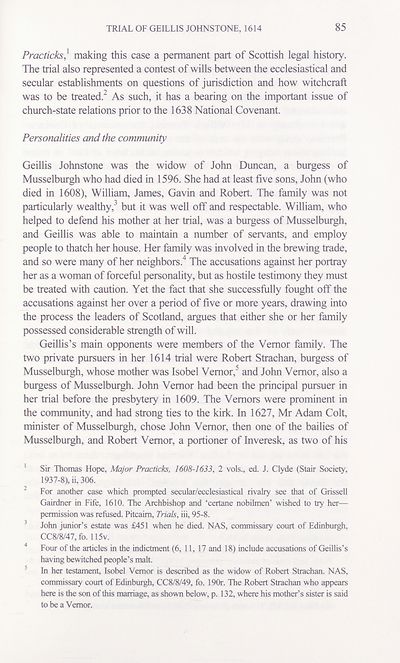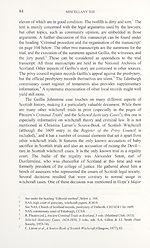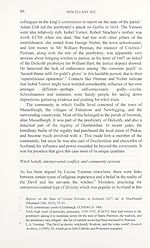Series 5 > Miscellany [of the Scottish History Society] XIII
(100) Page 85
Download files
Complete book:
Individual page:
Thumbnail gallery: Grid view | List view

TRIAL OF GEILLIS JOHNSTONE, 1614
85
Practicks' making this case a permanent part of Scottish legal history.
The trial also represented a contest of wills between the ecclesiastical and
secular establishments on questions of jurisdiction and how witchcraft
was to be treated.2 As such, it has a bearing on the important issue of
church-state relations prior to the 1638 National Covenant.
Personalities and the community
Geillis Johnstone was the widow of John Duncan, a burgess of
Musselburgh who had died in 1596. She had at least five sons, John (who
died in 1608), William, James, Gavin and Robert. The family was not
particularly wealthy,3 but it was well off and respectable. William, who
helped to defend his mother at her trial, was a burgess of Musselburgh,
and Geillis was able to maintain a number of servants, and employ
people to thatch her house. Her family was involved in the brewing trade,
and so were many of her neighbors.4 The accusations against her portray
her as a woman of forceful personality, but as hostile testimony they must
be treated with caution. Yet the fact that she successfully fought off the
accusations against her over a period of five or more years, drawing into
the process the leaders of Scotland, argues that either she or her family
possessed considerable strength of will.
Geillis’s main opponents were members of the Vemor family. The
two private pursuers in her 1614 trial were Robert Strachan, burgess of
Musselburgh, whose mother was Isobel Vemor,5 and John Vemor, also a
burgess of Musselburgh. John Vemor had been the principal pursuer in
her trial before the presbytery in 1609. The Vemors were prominent in
the community, and had strong ties to the kirk. In 1627, Mr Adam Colt,
minister of Musselburgh, chose John Vemor, then one of the bailies of
Musselburgh, and Robert Vemor, a portioner of Inveresk, as two of his
1 Sir Thomas Hope, Major Practicks, 1608-1633, 2 vols., ed. J. Clyde (Stair Society,
1937-8), ii, 306.
2 For another case which prompted secular/ecclesiastical rivalry see that of Grissell
Gairdner in Fife, 1610. The Archbishop and ‘certane nobilmen’ wished to try her—
permission was refused. Pitcairn, Trials, iii, 95-8.
3 John junior’s estate was £451 when he died. NAS, commissary court of Edinburgh,
CC8/8/47, fo. 115v.
4 Four of the articles in the indictment (6, 11, 17 and 18) include accusations of Geillis’s
having bewitched people’s malt.
5 In her testament, Isobel Vemor is described as the widow of Robert Strachan. NAS,
commissary court of Edinburgh, CC8/8/49, fo. 190r. The Robert Strachan who appears
here is the son of this marriage, as shown below, p. 132, where his mother’s sister is said
to be a Vemor.
85
Practicks' making this case a permanent part of Scottish legal history.
The trial also represented a contest of wills between the ecclesiastical and
secular establishments on questions of jurisdiction and how witchcraft
was to be treated.2 As such, it has a bearing on the important issue of
church-state relations prior to the 1638 National Covenant.
Personalities and the community
Geillis Johnstone was the widow of John Duncan, a burgess of
Musselburgh who had died in 1596. She had at least five sons, John (who
died in 1608), William, James, Gavin and Robert. The family was not
particularly wealthy,3 but it was well off and respectable. William, who
helped to defend his mother at her trial, was a burgess of Musselburgh,
and Geillis was able to maintain a number of servants, and employ
people to thatch her house. Her family was involved in the brewing trade,
and so were many of her neighbors.4 The accusations against her portray
her as a woman of forceful personality, but as hostile testimony they must
be treated with caution. Yet the fact that she successfully fought off the
accusations against her over a period of five or more years, drawing into
the process the leaders of Scotland, argues that either she or her family
possessed considerable strength of will.
Geillis’s main opponents were members of the Vemor family. The
two private pursuers in her 1614 trial were Robert Strachan, burgess of
Musselburgh, whose mother was Isobel Vemor,5 and John Vemor, also a
burgess of Musselburgh. John Vemor had been the principal pursuer in
her trial before the presbytery in 1609. The Vemors were prominent in
the community, and had strong ties to the kirk. In 1627, Mr Adam Colt,
minister of Musselburgh, chose John Vemor, then one of the bailies of
Musselburgh, and Robert Vemor, a portioner of Inveresk, as two of his
1 Sir Thomas Hope, Major Practicks, 1608-1633, 2 vols., ed. J. Clyde (Stair Society,
1937-8), ii, 306.
2 For another case which prompted secular/ecclesiastical rivalry see that of Grissell
Gairdner in Fife, 1610. The Archbishop and ‘certane nobilmen’ wished to try her—
permission was refused. Pitcairn, Trials, iii, 95-8.
3 John junior’s estate was £451 when he died. NAS, commissary court of Edinburgh,
CC8/8/47, fo. 115v.
4 Four of the articles in the indictment (6, 11, 17 and 18) include accusations of Geillis’s
having bewitched people’s malt.
5 In her testament, Isobel Vemor is described as the widow of Robert Strachan. NAS,
commissary court of Edinburgh, CC8/8/49, fo. 190r. The Robert Strachan who appears
here is the son of this marriage, as shown below, p. 132, where his mother’s sister is said
to be a Vemor.
Set display mode to:
![]() Universal Viewer |
Universal Viewer | ![]() Mirador |
Large image | Transcription
Mirador |
Large image | Transcription
Images and transcriptions on this page, including medium image downloads, may be used under the Creative Commons Attribution 4.0 International Licence unless otherwise stated. ![]()
| Scottish History Society volumes > Series 5 > Miscellany [of the Scottish History Society] XIII > (100) Page 85 |
|---|
| Permanent URL | https://digital.nls.uk/127314729 |
|---|
| Description | Over 180 volumes, published by the Scottish History Society, containing original sources on Scotland's history and people. With a wide range of subjects, the books collectively cover all periods from the 12th to 20th centuries, and reflect changing trends in Scottish history. Sources are accompanied by scholarly interpretation, references and bibliographies. Volumes are usually published annually, and more digitised volumes will be added as they become available. |
|---|


